Construction toys for preschoolers are revolutionizing early childhood education, transforming playtime into powerful learning experiences. As educators and parents worldwide recognize the profound impact of hands-on learning, these engaging tools have become essential in nurseries, kindergartens, and homes across the globe.
Table of Contents
- Understanding Construction Toys for Early Learning
- Developmental Benefits of Building Play
- Types of Construction Toys for Different Ages
- Wooden Blocks: The Foundation of Learning
- STEM Skills Through Construction Play
- Safety Standards and Quality Considerations
- Choosing the Right Construction Toys
- Integration in Educational Settings
- Maintenance and Longevity
- Future Trends in Educational Toys
Understanding Construction Toys for Early Learning
Construction toys for preschoolers encompass a diverse range of building materials designed specifically for children aged 2-6 years. These educational tools include wooden blocks, magnetic tiles, interlocking bricks, and specialized building sets that encourage young learners to explore, create, and problem-solve.

Research from the National Association for the Education of Young Children (NAEYC) confirms that construction play supports multiple developmental domains simultaneously. When children manipulate blocks and building pieces, they’re not just having fun—they’re developing critical thinking skills, spatial awareness, and mathematical reasoning.
Developmental Benefits of Building Play
The educational value of construction toys for preschoolers extends far beyond simple entertainment. Structured block play particularly enhances spatial reasoning, a crucial form of intelligence for STEM achievement.
Cognitive Development
Construction toys stimulate multiple areas of brain development. When preschoolers engage with building materials, they:
- Develop problem-solving abilities through trial and error
- Enhance spatial intelligence by visualizing three-dimensional structures
- Practice mathematical concepts including symmetry, patterns, and measurement
- Strengthen memory through planning and executing building projects
A study by Young Engineers revealed that children using STEM construction sets show a 30% improvement in fine motor skills compared to those engaged in non-tactile activities.
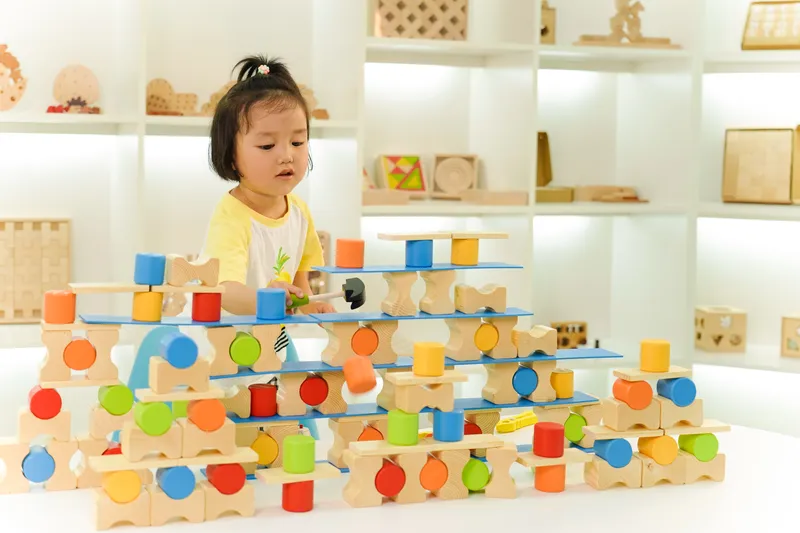
Physical Development
Construction toys for preschoolers provide excellent opportunities for developing both fine and gross motor skills:
- Fine Motor Skills: Grasping small pieces, connecting blocks, and precise placement movements strengthen hand muscles and improve dexterity
- Hand-Eye Coordination: Aligning pieces and balancing structures enhances visual-motor integration
- Bilateral Coordination: Using both hands simultaneously promotes brain hemisphere communication
Social-Emotional Growth
Group construction activities foster essential social skills. Research indicates that building and connecting toys rank highly for promoting creativity, social interaction, and critical thinking.
Children learn to:
- Collaborate and negotiate with peers
- Share materials and take turns
- Express ideas verbally
- Develop patience and persistence
- Build confidence through successful completion of projects
Types of Construction Toys for Different Ages
Understanding age-appropriate construction toys ensures optimal developmental benefits and safety.
Ages 2-3: Foundation Building
For toddlers, construction toys should feature:
- Large, easy-to-grasp pieces (minimum 1¼ inches diameter)
- Simple connection mechanisms
- Bright, engaging colors
- Soft or rounded edges
Recommended options include oversized wooden blocks, soft foam bricks, and large magnetic tiles. These toddler-friendly construction toys build confidence and basic motor skills.

Ages 3-4: Skill Development
Preschoolers at this stage benefit from:
- Medium-sized interlocking blocks
- Simple gear and pulley systems
- Themed building sets (vehicles, buildings)
- Basic pattern cards for guided building
These construction toys for preschoolers introduce more complex concepts while maintaining safety standards.
Ages 5-6: Advanced Challenges
Older preschoolers and kindergarteners thrive with:
- Smaller, more intricate pieces
- Multi-step building projects
- Marble run components
- Construction sets with moving parts
Wooden Blocks: The Foundation of Learning
Wooden blocks construction toys for preschoolers remain the gold standard in educational materials. Their timeless appeal combines with proven developmental benefits, making them essential in any learning environment.
Why Wooden Blocks Excel
Sustainability and Safety High-quality wooden blocks, particularly those made from FSC-certified wood, offer:
- Non-toxic, natural materials
- Durability lasting generations
- Eco-friendly manufacturing
- Smooth, splinter-free surfaces
Educational Versatility Wooden building blocks support open-ended play, allowing children to:
- Create unlimited designs without prescribed outcomes
- Explore balance and gravity naturally
- Experience authentic textures and weight
- Develop spatial reasoning through physical manipulation
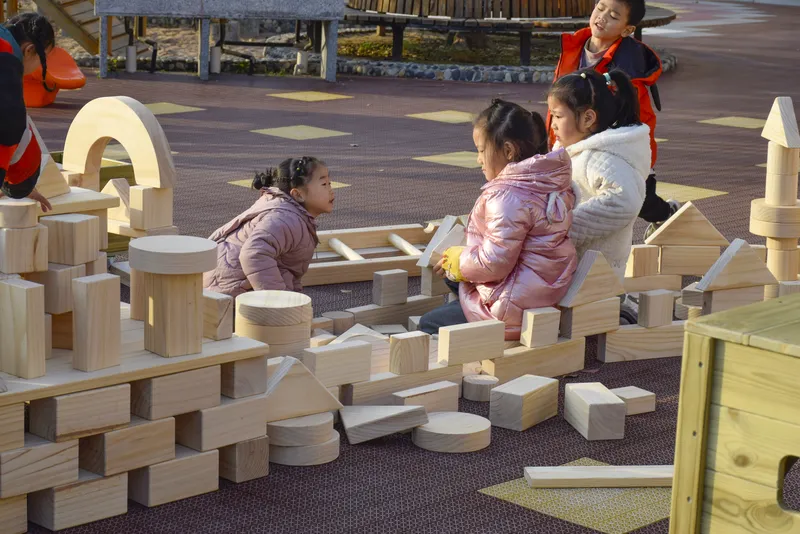
Choosing Quality Wooden Construction Toys
When selecting wooden construction toys for preschoolers, educational institutions and parents should prioritize:
- Material Quality: Look for hardwoods like maple or beech
- Finish: Non-toxic, water-based sealants
- Precision: Accurately cut pieces for stable building
- Variety: Multiple shapes (cubes, cylinders, arches, triangles)
- Storage: Organized systems for easy cleanup
Manufacturers and specialized educational toy producers offer sets specifically designed for institutional use, featuring durability and comprehensive piece assortments.
STEM Skills Through Construction Play
Construction toys for preschoolers serve as ideal introductions to STEM (Science, Technology, Engineering, Mathematics) concepts. The benefits of STEM toys extend beyond academic preparation, fostering curiosity and innovative thinking.
Science Exploration
Building play naturally introduces scientific concepts:
- Physics: Balance, stability, gravity, force
- Properties of Materials: Weight, texture, density
- Cause and Effect: Understanding how structures fall or stand
- Scientific Method: Hypothesis testing through building experiments
Technology Integration
Modern construction toys increasingly incorporate technological elements:
- Magnetic connections teaching magnetism principles
- Gear systems demonstrating mechanical advantage
- Light-up components introducing circuits
- App-connected sets bridging physical and digital learning
Engineering Fundamentals
Construction toys for preschoolers provide foundational engineering experiences:
- Structural design and architectural principles
- Problem-solving through design challenges
- Understanding load distribution and support
- Iterative design processes (build, test, modify, rebuild)

Mathematical Thinking
Building activities inherently teach math concepts:
- Geometry: Shape recognition and spatial relationships
- Measurement: Comparing sizes, heights, lengths
- Patterns: Creating and recognizing sequences
- Counting: Quantifying pieces and structures
- Symmetry: Creating balanced designs
Safety Standards and Quality Considerations
Safety remains paramount when selecting construction toys for preschoolers. Understanding international safety standards ensures you provide secure learning environments.
Key Safety Certifications
Look for these essential certifications:
- ASTM F963: American Society for Testing and Materials standard
- CPSC Compliance: U.S. Consumer Product Safety Commission requirements
- EN71: European safety standard for toys
- CE Marking: European conformity certification
- ISO 8124: International safety standard
According to the Consumer Product Safety Commission, toys for children under 8 must not have hazardous sharp edges, points, or small parts that pose choking hazards.
Material Safety
Quality construction toys for preschoolers should feature:
- Non-Toxic Paints: Lead-free, food-grade finishes
- BPA-Free Plastics: When plastic components are included
- Smooth Surfaces: No splinters, rough edges, or sharp corners
- Appropriate Size: Pieces larger than 1¼ inches diameter for children under 3
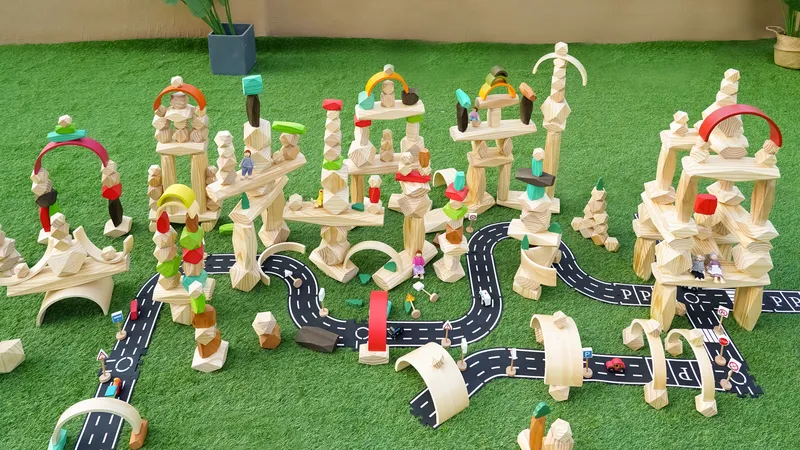
Age-Appropriate Guidelines
Nemours KidsHealth provides comprehensive guidance on age-appropriate toy selection:
- Under 3 years: No small parts, large pieces only
- 3-5 years: Supervise with smaller components
- 5+ years: Can handle more intricate pieces with minimal supervision
Quality Indicators
High-quality construction toys demonstrate:
- Durability: Withstand repeated use and cleaning
- Precision Manufacturing: Pieces fit together smoothly
- Weight Consistency: Balanced for stable building
- Color Fastness: Colors don’t bleed or fade
- Warranty: Manufacturer stands behind product quality
Choosing the Right Construction Toys
Selecting optimal construction toys for preschoolers requires considering multiple factors to ensure educational value, safety, and engagement.
Assessment Criteria
For Educational Institutions:
- Quantity: Sufficient pieces for multiple children (minimum 100+ pieces for classroom sets)
- Variety: Diverse shapes and sizes to support varied play
- Storage: Organized containment systems for classroom management
- Durability: Commercial-grade quality for high-frequency use
- Educational Value: Alignment with curriculum standards
For Parents and Home Use:
- Child’s Interest: Age-appropriate challenges that engage
- Growth Potential: Toys that evolve with developing skills
- Space Considerations: Storage and play area requirements
- Budget: Quality investment pieces that provide long-term value
- Integration: Compatibility with existing toys
Popular Construction Toy Categories
- Traditional Wooden Blocks
- Unit blocks following standard measurements
- Natural wood finish or painted varieties
- Multiple geometric shapes
- Suitable for ages 2-10+
- Magnetic Construction Toys
- Magnetic tiles (Magna-Tiles style)
- Magnetic balls and rods
- Ages 3+ with proper supervision
- Excellent for exploring geometry
- Interlocking Brick Systems
- Large DUPLO-style bricks for toddlers
- Standard LEGO for older preschoolers
- Themed sets or basic building blocks
- Ages 2+
- Gear and Mechanism Sets
- Moving parts and connections
- Introduction to engineering principles
- Often includes vehicles or machines
- Ages 4+

Vendor Selection for Bulk Purchases
Educational institutions and distributors should consider:
- Manufacturer Reputation: Established brands with verified safety records
- Certifications: Complete documentation of safety compliance
- Customization Options: Branding or specific educational focus
- Bulk Pricing: Volume discounts for classroom sets
- Shipping and Logistics: Reliable delivery and packaging
- After-Sales Support: Replacement pieces and customer service
Integration in Educational Settings
Construction toys for preschoolers achieve maximum impact when intentionally integrated into educational curricula and daily routines.
Classroom Setup
Dedicated Building Centers Create inviting spaces for construction play:
- Low shelves with clearly labeled storage bins
- Adequate floor space for multiple children
- Display area for showcasing completed projects
- Mirrors to view structures from different angles
- Reference materials (picture cards, idea books)
Scheduling and Rotation Optimize engagement through strategic planning:
- Daily free-play periods featuring construction toys
- Guided building activities aligned with learning themes
- Rotation of available pieces to maintain interest
- Special challenges or building competitions
- Documentation of structures through photography
Teacher-Facilitated Activities
Educators can enhance construction play by:
Open-Ended Challenges
- “Build the tallest tower possible”
- “Create a structure using only triangular pieces”
- “Design a home for our classroom pet”
Curriculum Integration
- Math: Building structures with specific number requirements
- Science: Exploring stability and balance
- Literacy: Building scenes from storybooks
- Social Studies: Constructing community buildings
Guided Discussions
- Describing building processes using mathematical language
- Comparing and contrasting different structures
- Problem-solving when buildings collapse
- Collaborative planning and teamwork
Construction play naturally supports EYFS (Early Years Foundation Stage) and KS1 curriculum themes across multiple learning domains.
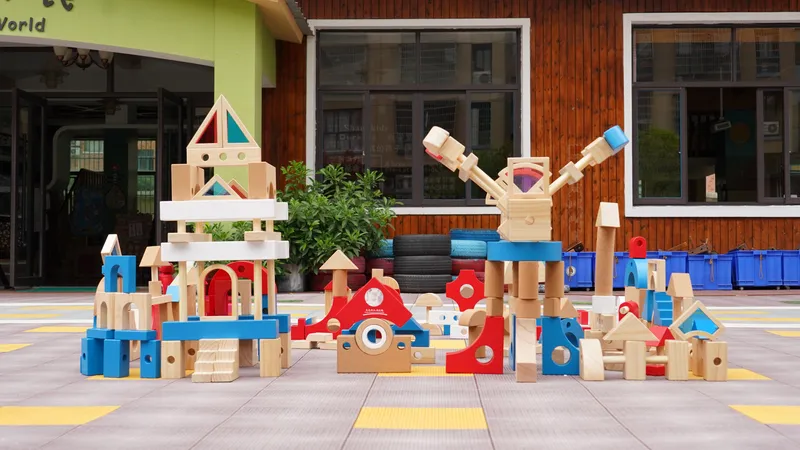
Assessment and Documentation
Track developmental progress through:
- Photo Documentation: Before/after images of structures
- Portfolio Development: Collection of building achievements
- Observation Notes: Recording problem-solving approaches
- Parent Communication: Sharing learning through construction play
Maintenance and Longevity
Quality construction toys for preschoolers represent significant investments. Proper care ensures decades of educational value.
Cleaning and Sanitization
Wooden Toys
- Wipe with damp cloth and mild soap
- Avoid submersion in water
- Vinegar-water solution for disinfecting
- Periodic oiling for natural wood finishes
- Air dry completely before storage
Plastic Components
- Dishwasher safe (check manufacturer guidelines)
- Warm soapy water for hand washing
- Disinfectant wipes for quick cleaning
- Avoid harsh chemicals that may damage plastic
Storage Solutions
Effective organization extends toy life:
- Clear bins for easy piece identification
- Labeled containers for different sets
- Climate-controlled storage to prevent warping
- Secure containers preventing loss of pieces
- Accessible height for independent cleanup
Repair and Replacement
Maintain inventory through:
- Regular inspection for damaged pieces
- Immediate removal of hazardous items
- Manufacturer contact for replacement parts
- Sanding rough spots on wooden pieces
- Proper disposal of beyond-repair items
Future Trends in Educational Construction Toys
The evolution of construction toys for preschoolers continues as manufacturers blend traditional play values with modern innovations.
Emerging Technologies
Augmented Reality Integration Some manufacturers now offer apps that:
- Recognize built structures through device cameras
- Provide building challenges and instructions
- Animate creations digitally
- Track construction progress and achievements
Smart Blocks Electronic components embedded in building pieces:
- Light-up connections
- Sound effects
- Conductivity teaching circuits
- Bluetooth connectivity for app interaction
Sustainability Focus
Environmental consciousness drives industry changes:
- Increased use of bamboo and recycled materials
- Water-based, plant-derived finishes
- Minimal plastic packaging
- Carbon-neutral manufacturing processes
- Toy recycling programs
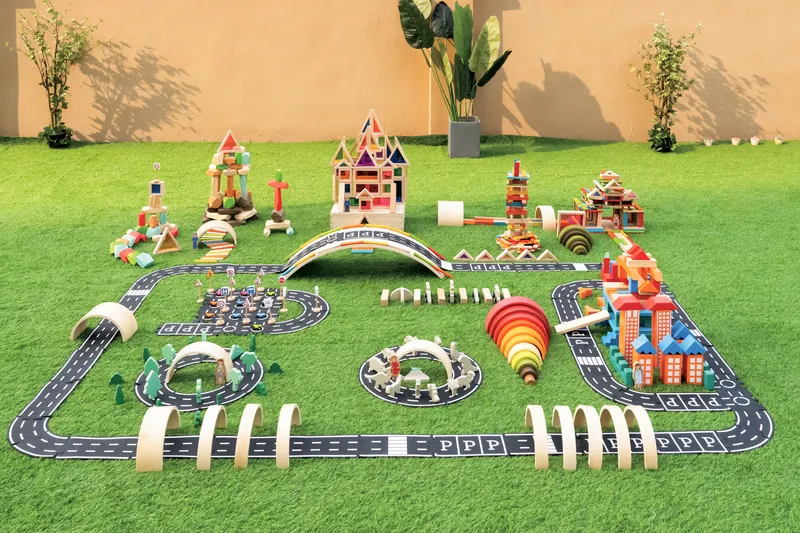
Inclusive Design
Modern construction toys increasingly feature:
- Pieces accommodating different grip strengths
- High-contrast colors for visual accessibility
- Textured surfaces for sensory exploration
- Gender-neutral designs and colors
- Culturally diverse building themes
STEAM Integration
Expanding beyond STEM to include Arts:
- Building sets with aesthetic design focus
- Architectural-inspired pieces
- Color theory exploration through construction
- Artistic expression through three-dimensional creation
Conclusion
Construction toys for preschoolers represent far more than simple playthings—they are powerful educational tools shaping young minds and preparing children for future success. From traditional wooden blocks to innovative magnetic systems, these hands-on learning materials develop critical thinking, creativity, spatial awareness, and social skills essential for lifelong learning.
For educators, parents, and distributors seeking quality construction toys, prioritizing safety certifications, developmental appropriateness, and educational value ensures optimal outcomes. High-quality wooden blocks construction toys for preschoolers, in particular, offer unmatched durability, sustainability, and versatility, making them worthy investments in children’s futures.
Ready to Invest in Quality Construction Toys?
Explore our extensive collection of educational building toys manufactured with the highest safety standards and educational value in mind. Contact our team today to discuss bulk orders for your educational institution or distribution needs.
Frequently Asked Questions
Q: What age is appropriate to introduce construction toys? A: Simple construction toys can be introduced as early as 18 months with large, soft blocks. Age 2-3 is ideal for beginning wooden block play with appropriate supervision.
Q: How many pieces should a classroom construction set include? A: For a preschool classroom of 15-20 children, aim for 200-300 pieces to allow multiple building projects simultaneously.
Q: Are wooden or plastic construction toys better? A: Both have merits. Wooden toys offer superior durability, sustainability, and sensory experiences. Plastic pieces may offer color variety and specialized connections. Many educators recommend a combination.
Q: How do construction toys support literacy development? A: Construction play enhances literacy through vocabulary development (naming shapes, describing building processes), following sequential instructions, and storytelling about created structures.
Q: What’s the difference between open-ended and structured building toys? A: Open-ended toys (like unit blocks) have no prescribed outcome, encouraging creativity. Structured sets include instructions for specific models, teaching following directions and precision